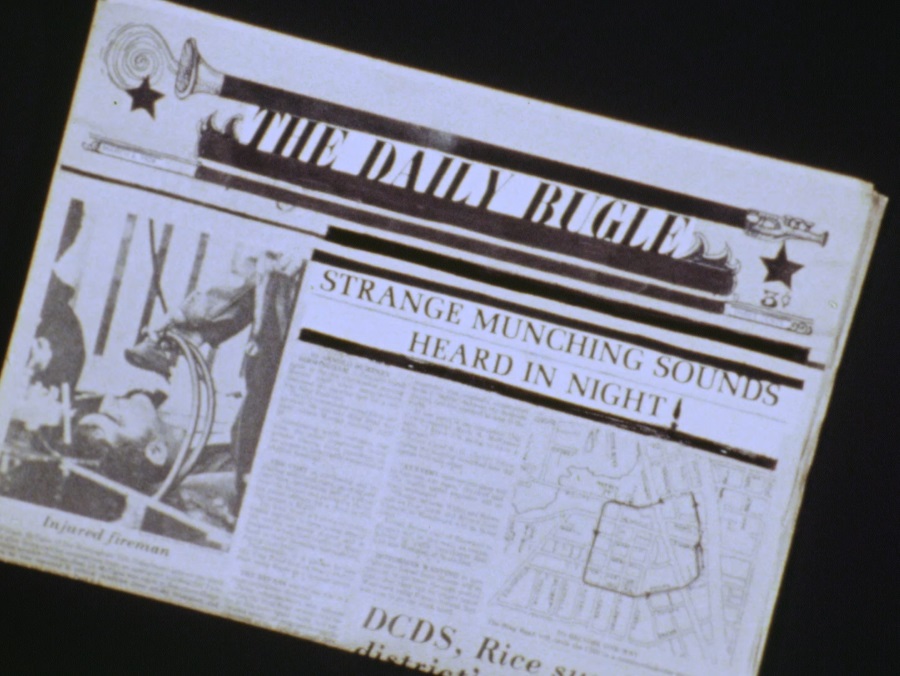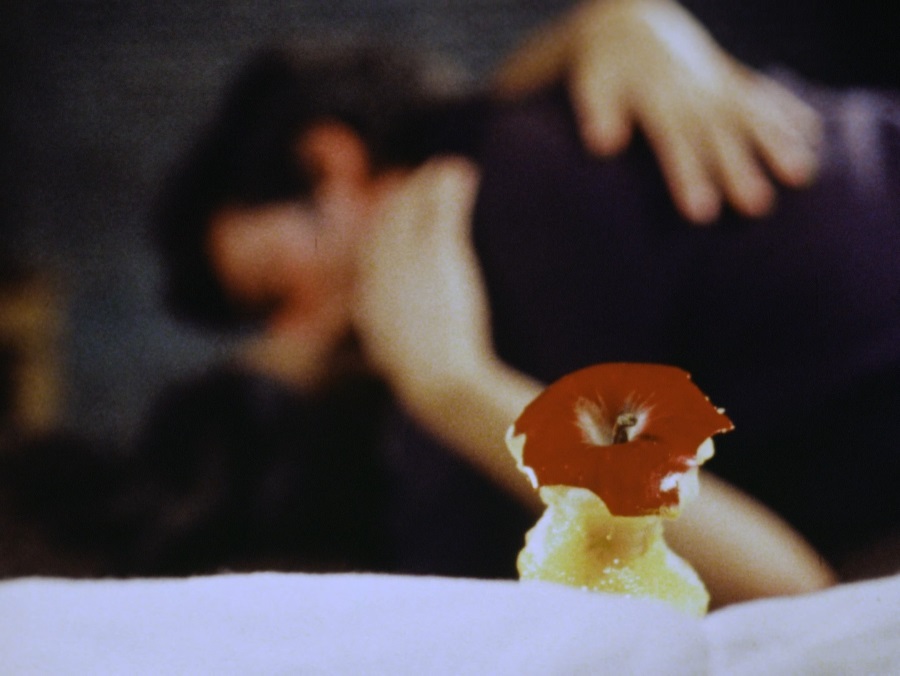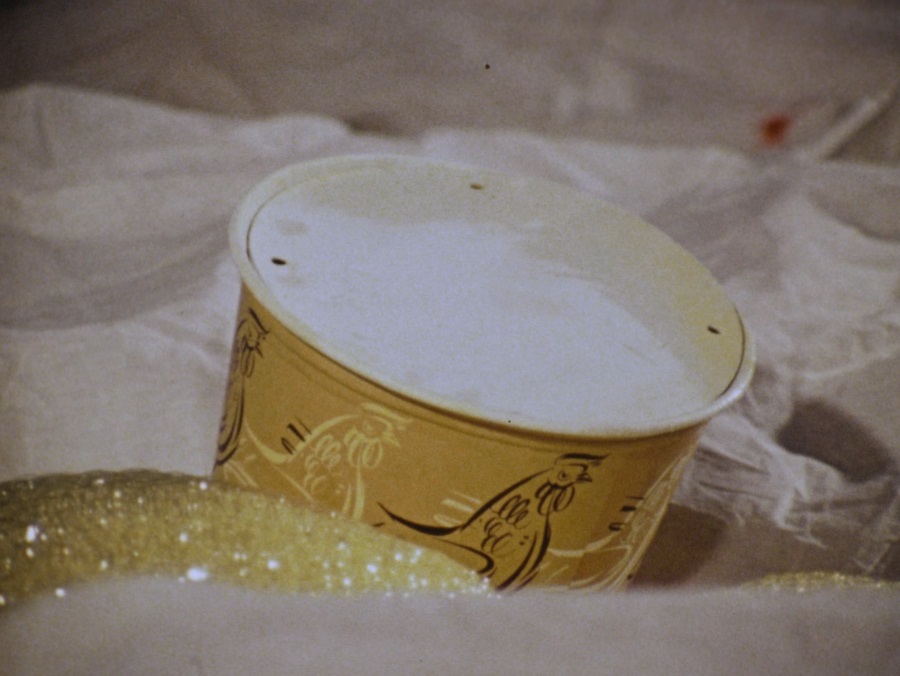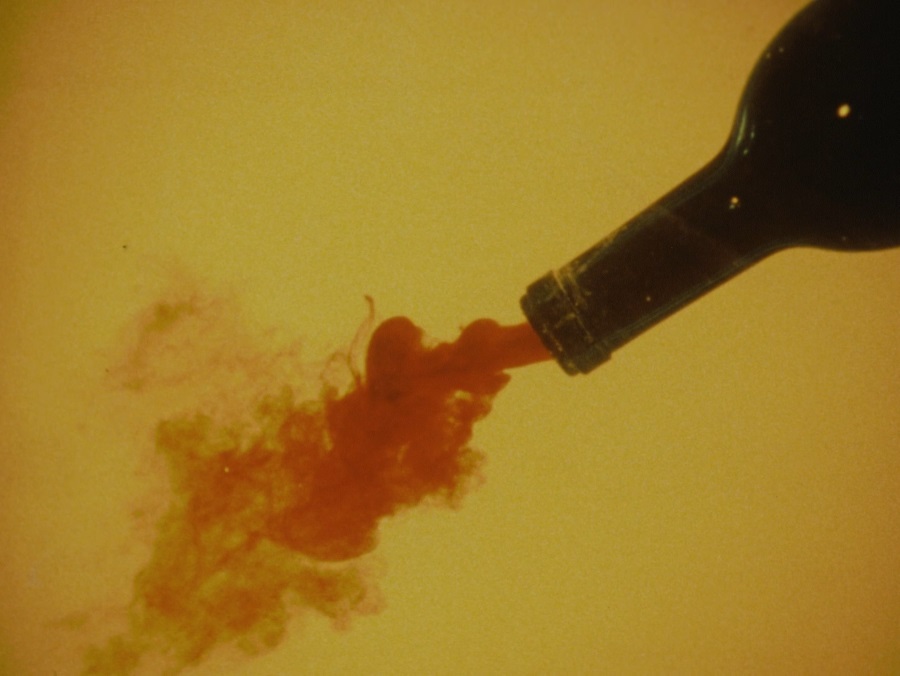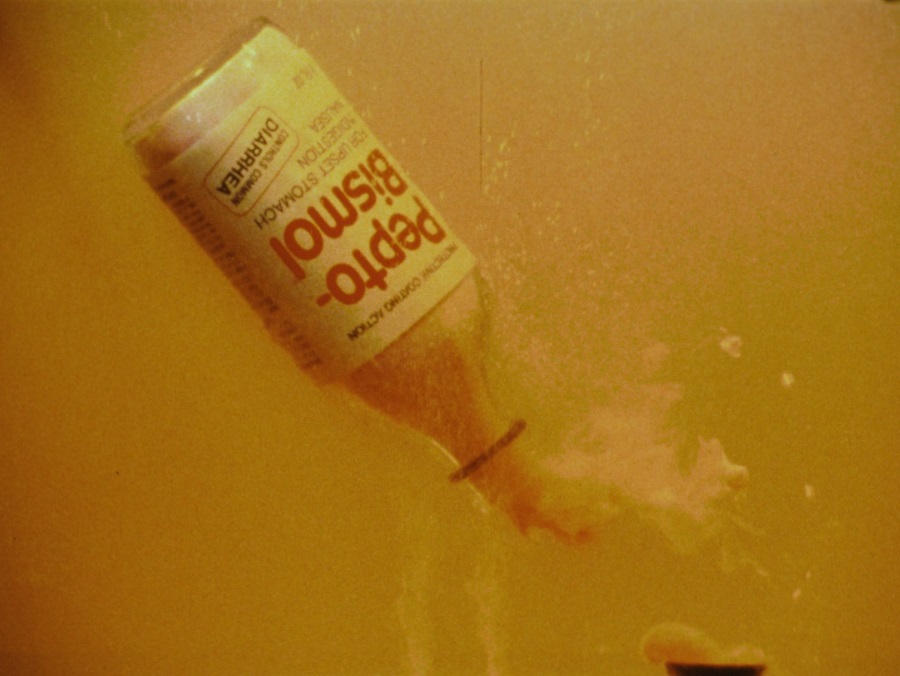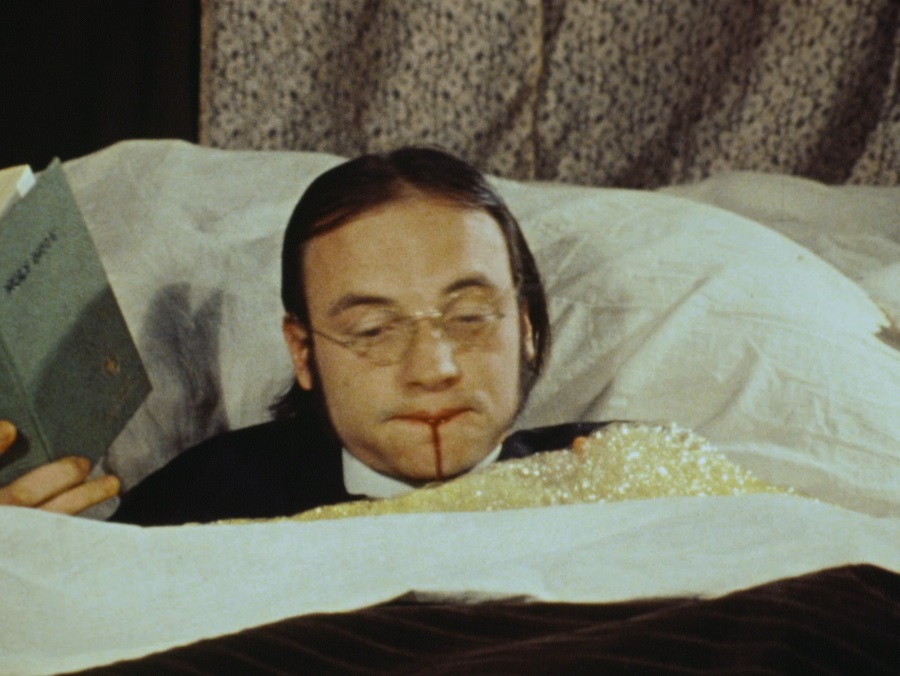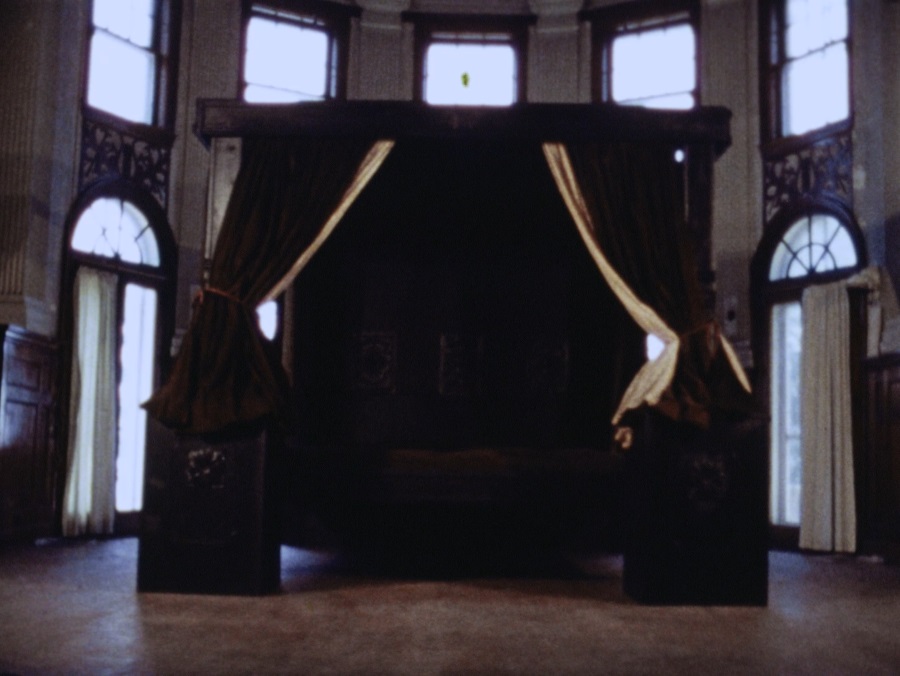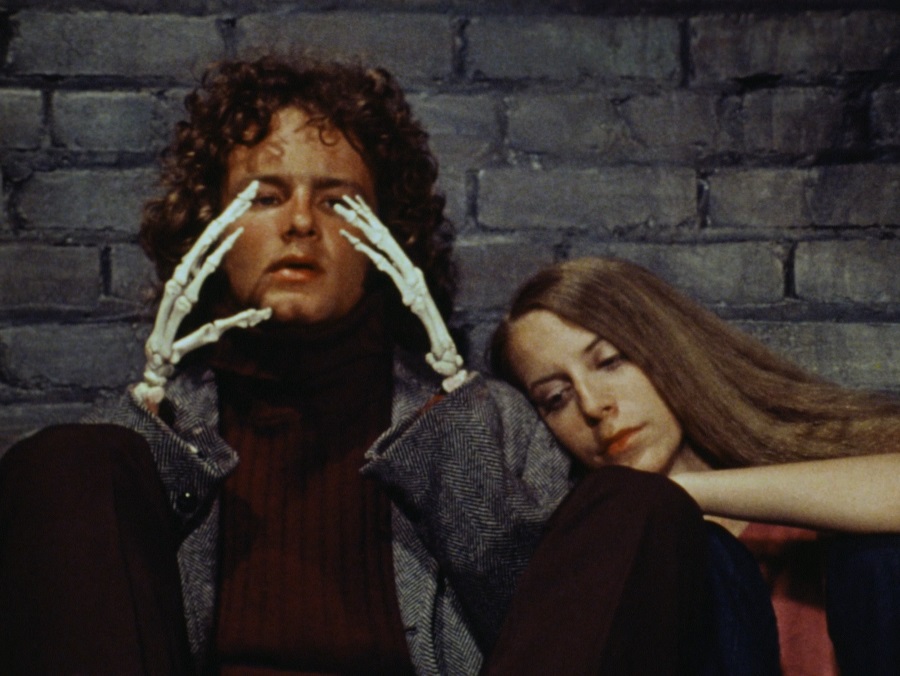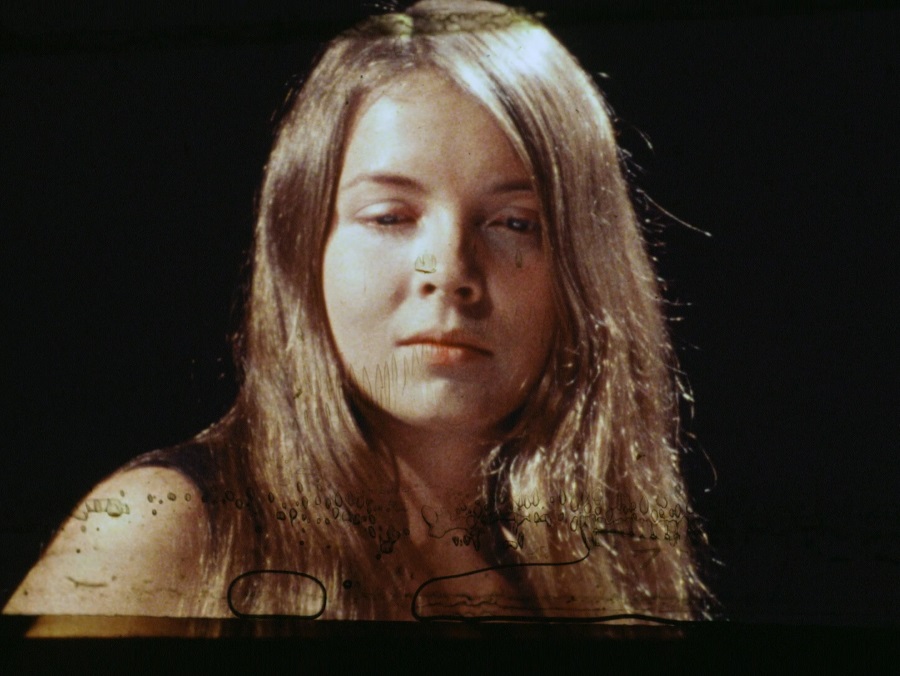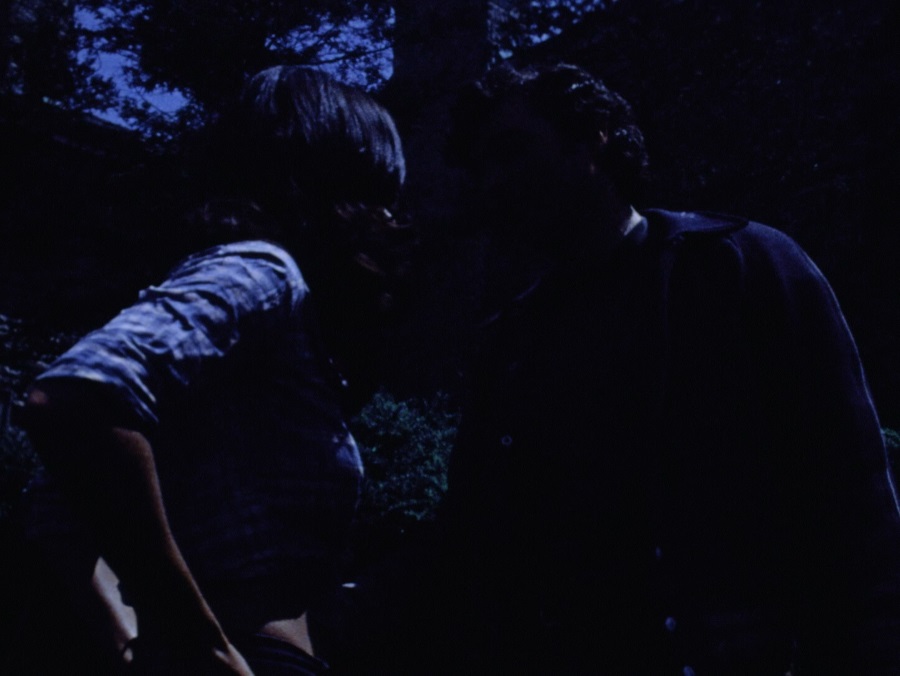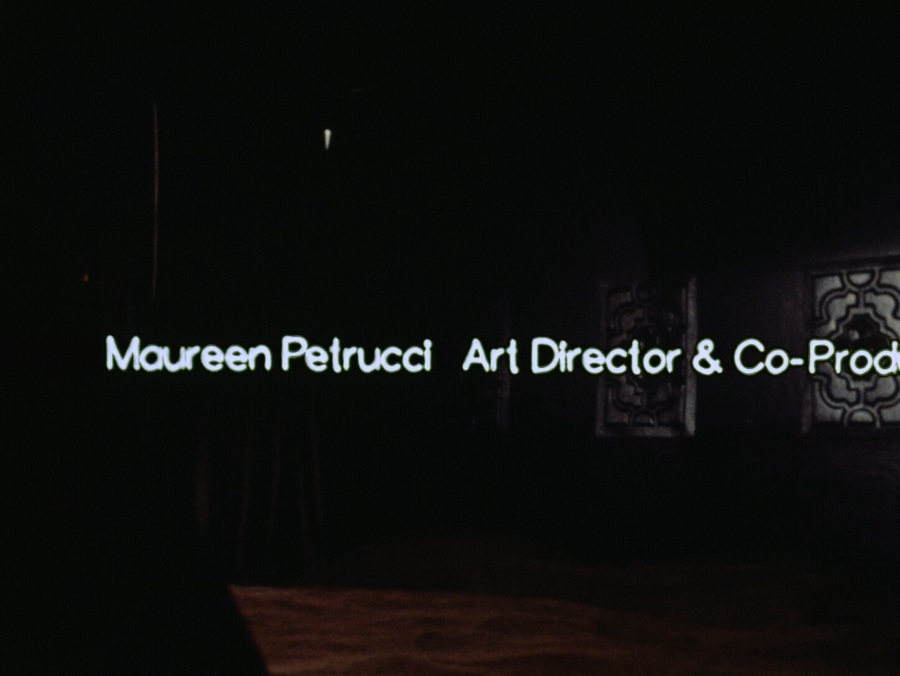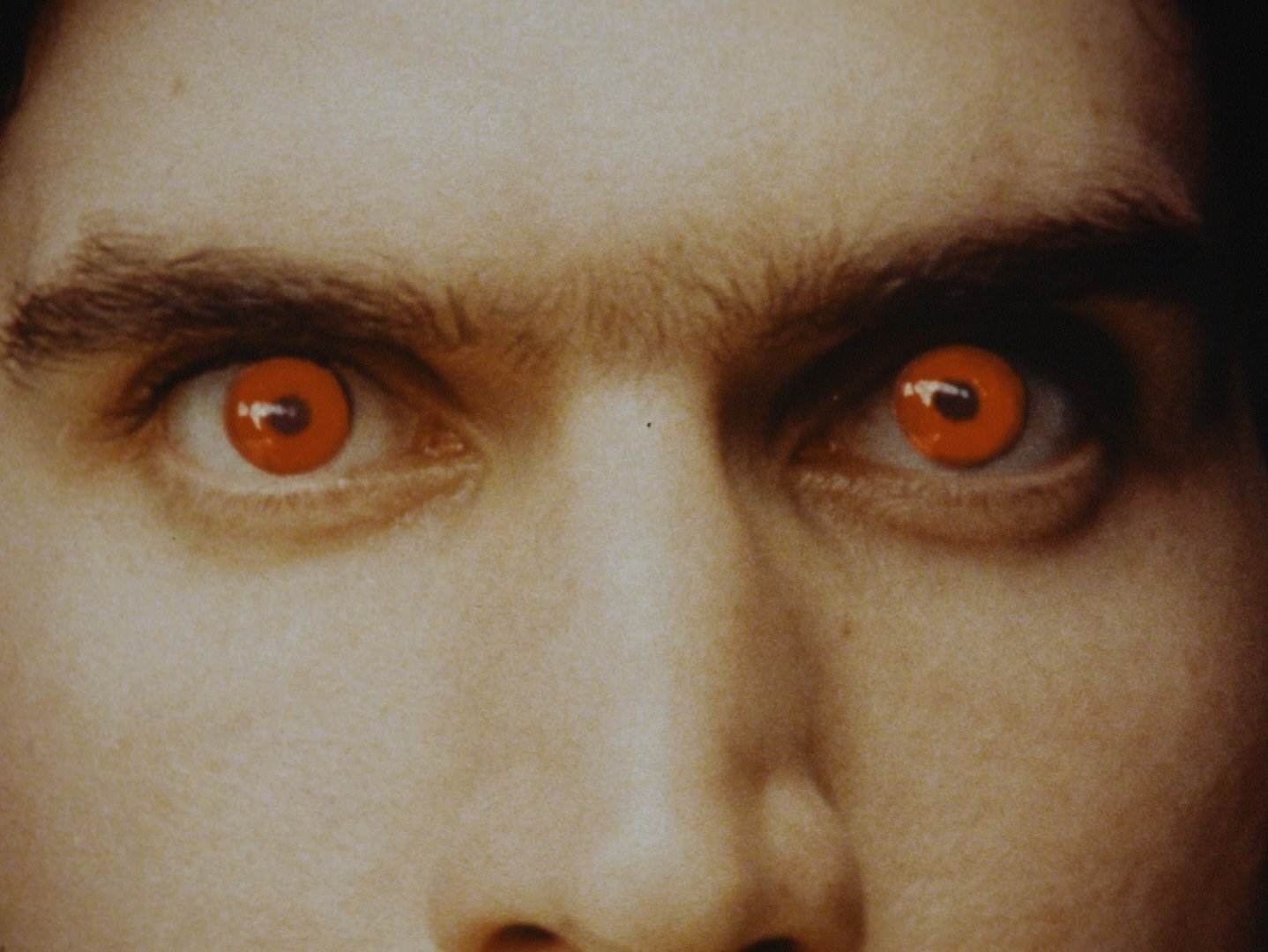| Reviews & Columns |
|
Reviews DVD TV on DVD Blu-ray 4K UHD International DVDs In Theaters Reviews by Studio Video Games Features Collector Series DVDs Easter Egg Database Interviews DVD Talk Radio Feature Articles Columns Anime Talk DVD Savant Horror DVDs The M.O.D. Squad Art House HD Talk Silent DVD
|
DVD Talk Forum |
|
|
| Resources |
|
DVD Price Search Customer Service #'s RCE Info Links |
|
Columns
|
|
|
Death Bed: The Bed That Eats
Cult Epics // Unrated // June 3, 2014 // Region 0
List Price: $24.98 [Buy now and save at Amazon]
Extra! Extra! Read all about it!
Death Bed: The Bed That Eats Apples
Death Bed: The Bed That Eats Fried Chicken
Death Bed: The Bed ThatEatsDrinks a Fine Merlot
Death Bed: The Bed That ::buurrrrrrppppp::
Death Bed: The Bed That Eats People!
George Barry was a man with a dream. No, really, he had a nightmare about a bed that enveloped its victims, smothering them into a dark, eternal slumber. That inspired Barry -- who had no background or formal education in film or anything like that -- to develop that germ of an idea into a full-fledged horror flick. He rustled up a shoestring of a budget in 1972, shot whenever he had the time and money over the next couple of years, and poked around with post-production off and on until finally having a finished cut in '77. A couple of tiny distributors nibbled around Death Bed: The Bed That Eats, but no one actually bit. Barry pretty much forgot about that whole thing and moved on with his life, leaving the world of feature filmmaking behind him.
Flash forward to the early aughts. In the wee hours of the morning, Barry was innocently clicking around on a cult cinema message board when he came across a thread titled "Do you know this movie???" Intrigued, he clicked one more time, and it turns out that the guy was asking about Death Bed. One of those distributors Barry was trying to strike a deal with all those decades earlier had covertly made a video master, and bootleg copies of Death Bed had been making the rounds on VHS in Europe ever since. Nosing around further, Barry started stumbling across reviews of a movie he had no idea had ever seen the light of day. Never having landed in theaters anywhere across the globe, Cult Epics' DVD release of Death Bed in 2003 marked the first-ever official release of the movie, more than thirty years after cameras started rolling. So, yeah, technically "direct to video", just without the "direct" part so much. Here we are more than four decades after George Barry first dreamt about a flesh-eating bed, staring down at a shiny, new Blu-ray disc and a fancy high-def remaster.
Its title is pretty much truth in advertising; Death Bed: The Bed That Eats is indeed about a bed of death that eats people. There's a whole backstory about a besotted tree demon, post-coital tears of blood, and a legacy of terror, but at the end of the day, it all boils down to a really, really hungry bed. Anyone who decides to bust into what's left of this decaying mansion to sleep or screw winds up on the menu. Disappointingly for the bed, its appetite is so ravenous that the long-since-abandoned estate has scared off just about everyone, and it doesn't help that the bed is hidden somewhere down in the cellar. What I'm getting at is that it's been a while since the bed was fed. Okay, so Death Bed opens with the bed munching on an amorous couple's picnic lunch before devouring them as well. A Victorian artist who the bed had mystically trapped inside a painting (long story) taunts his captor into psychokinetically leveling the mansion until all that's left is the cellar, which for some reason is above-ground. Something like a decade later, three women having a Just Us Girls Weekend decide to hole up in that cellar. The mere sight of one of them rattles the bed to its very core, but it picks off the rest of the lot, one by one, whenever it gets a rumbly in its tumbly. Oh, but that last little morsel that's being saved for last...? The bed is right to be afraid.
Like a lot of you who've clicked over to this review, I first heard about Death Bed: The Bed That Eats from a Patton Oswalt bit. Having heard that standup routine more times than I could count, I went into Death Bed expecting some double-digit-IQ, so-bad-it's-good schlocksterpiece that's as formulaic as a movie about a man-eating piece of demonspawned furniture could be. Turns out that Death Bed is quite a bit better and quite a bit worse than all that. For one, writer/producer/director George Barry didn't set out to make some balls-to-the-wall exploitation flick. Death Bed unfolds at a very deliberate pace, and the storytelling can be kind of elliptical. Instead of just "here's a pre-credit scare, here's the sinister origin of the death bed, and here's it eating people for seventysomeodd minutes", it's all kind of jumbled together, with a massive infodump unveiled in the middle of a frantic flurry of flashbacks halfway through. Barry notes in his audio commentary that he used to watch drive-in exploitation as well as European arthouse cinema in his younger days, and you can genuinely see both influences here. I'm sure that Barry watched his share of comedies as well. At least, Death Bed has an undeniable sense of humor. I'm not talking about unintentional laughs, although there are those too. Hell, look at the newspaper article and the bottle of Pepto-Bismol I snapped up at the top there. For crying out loud, the bed is stressed to the point of getting ulcers; there's no way that Death Bed was meant to be taken as a straightahead slice of horror. That's not to say it's a spoof, nor is it all that successful in trying to temper the terror with those sorts of smirks, but Death Bed is clearly aiming for something different.
There's not a lot about Death Bed that really works, though. It's borderline-impossible to make a static piece of furniture come across as menacing, and...yeah, that's a problem. The plotting is like something out of a peyote-induced fever dream...not the easiest thing to latch onto and follow its threads of logic. Death Bed suffers from an extremely erratic pace. Despite clocking in at just 78 minutes, there are so many sequences that aimlessly drag on forever. Hell, the movie opens with right at a full minute of completely black leader or whatever, backed by the sound of someone chomping into an apple over and over and over. Death Bed doesn't take much of a stab at characterization, to the point where a bunch of the folks in front of the camera aren't even given names. Pretty much any sequence without the bed eating someone or something winds up being a tough slog. On the other hand, Death Bed wields a strange and unique charm that kept entrancing me even when I was bored stiff. I'll always take an interesting failure over some uninspired, by-the-numbers horror flick. Not for mass consumption or whatever, but if you've made it this far in the review, chances are that Death Bed: The Bed That Eats is the movie for you. Recommended.
Video
The film elements for Death Bed: The Bed That Eats weren't lovingly stored in some climate-controlled vault or in a Kansan salt mine some sixty stories beneath the surface. There was one lone 16mm print surviving, and that's what was transferred for this shiny new high-def remaster. Considering that this was a no-budget movie shot on 16mm more than forty years ago, Death Bed looks pretty damned great. It's not exactly in the same league as The Evil Dead or Basket Case when it comes to revelatory presentations of 16mm cult cinema on Blu-ray, but definition and detail are as solid as could possibly be expected. There's a good bit of speckling but very little showstopping damage. This moment around 25 minutes in is the only really nasty hiccup:
I'm glad to see that the gritty 16mm texture is present and accounted for, with Cult Epics respectfully using little-to-no noise reduction to clean up the image. The AVC encode has been given enough headroom to ably handle all that film grain too. Black levels are respectable as well. Its palette has an unmistakeably vintage-16mm look to it but is still rendered very nicely. I don't have Cult Epics' DVD from 2003 handy to do a direct comparison, but the colors on this Blu-ray disc look considerably better saturated than the screencaps and video clips from that earlier release that are floating around online. There are exceptions, yeah, such as this oppressively underlit day-for-night sequence early on, but I don't think there's a whole lot they could do there:
Death Bed exposes what I'm assuming is the full 1.33:1 16mm aperture. Although Death Bed was always intended to land a theatrical release, I'm not sure how carefully composed it was to accommodate eventual matting to widescreen. In any event, this is the only aspect ratio in which Death Bed has ever been seen, and George Barry has clearly given this his sign of approval, so I'm not going to complain. I will admit to being puzzled by some of the cropped text in the opening credits, though:
It's kind of my job to nitpick about those sorts of things, but I really don't want to sound like I'm complaining. There are only a tiny, tiny handful of disappointing moments, and none of them get in the way of my enjoyment of a film I never would've thought I'd be able to experience in 1080p. Cult Epics has clearly taken this release of Death Bed very seriously, and given the severe limitations they had to work through, what they've managed to accomplish here is nothing short of extraordinary.
Audio
Death Bed: The Bed That Eats piles on two 16-bit DTS-HD Master Audio soundtracks: one in stereo and the other remixed to 5.1. The remix doesn't stray too far from what I'm assuming are Death Bed's monaural origins. The rear channels are mixed low enough that I could barely hear them, and instead of heaping on forced pans or gimmicky discrete effects, they're basically just more of the same in every speaker. Yeah, dialogue and the like bleed into the surrounds, and it felt like I was hearing the same effects behind me as I was in front of me. Don't expect a great deal of stereo separation or anything, and the subwoofer never really makes its presence known. It's to the point that Death Bed really doesn't sound as if it's been remixed at all.
Death Bed was almost entirely shot without sync sound, meaning that just about everything you're hearing -- every line of dialogue and every sound effect -- was recorded after the fact...and not especially well either. The creaky door sounds like someone rubbing his thumb against a balloon, for instance. Despite having been recorded in a professional studio, there's approaching zero dynamic range. Dialogue is harsh and sibilant. A persistent hiss refuses to relent, and there are some occasional pops and crackles as well. Basically, Death Bed shows its age and meager budget and then some.
There are no dubs or subtitle streams this time around.
Extras
The original DVD from Cult Epics had just one extra: a five and a half minute introduction (SD) by writer/director/producer George Barry. That's been carried over to this Blu-ray release, and impressively enough, a stack of new extras has been produced to go along with it.
The only thing missing from the original DVD release is the set of liner notes.
The Final Word
I don't know how much of a review you need. If you think you'd want to shell out twenty bucks to buy a hopelessly obscure, forty year old movie called Death Bed: The Bed That Eats, you're probably right. There are clearly more than a couple of us out there; not only has Cult Epics gone to the time and expense of retransferring and remastering this nearly-lost film in high definition, but they've assembled a healthy smattering of brand new extras along the way. Recommended to anyone who's adventurous enough.
Death Bed: The Bed That Eats Apples
Death Bed: The Bed That Eats Fried Chicken
Death Bed: The Bed That
Death Bed: The Bed That ::buurrrrrrppppp::
Death Bed: The Bed That Eats People!
George Barry was a man with a dream. No, really, he had a nightmare about a bed that enveloped its victims, smothering them into a dark, eternal slumber. That inspired Barry -- who had no background or formal education in film or anything like that -- to develop that germ of an idea into a full-fledged horror flick. He rustled up a shoestring of a budget in 1972, shot whenever he had the time and money over the next couple of years, and poked around with post-production off and on until finally having a finished cut in '77. A couple of tiny distributors nibbled around Death Bed: The Bed That Eats, but no one actually bit. Barry pretty much forgot about that whole thing and moved on with his life, leaving the world of feature filmmaking behind him.
Flash forward to the early aughts. In the wee hours of the morning, Barry was innocently clicking around on a cult cinema message board when he came across a thread titled "Do you know this movie???" Intrigued, he clicked one more time, and it turns out that the guy was asking about Death Bed. One of those distributors Barry was trying to strike a deal with all those decades earlier had covertly made a video master, and bootleg copies of Death Bed had been making the rounds on VHS in Europe ever since. Nosing around further, Barry started stumbling across reviews of a movie he had no idea had ever seen the light of day. Never having landed in theaters anywhere across the globe, Cult Epics' DVD release of Death Bed in 2003 marked the first-ever official release of the movie, more than thirty years after cameras started rolling. So, yeah, technically "direct to video", just without the "direct" part so much. Here we are more than four decades after George Barry first dreamt about a flesh-eating bed, staring down at a shiny, new Blu-ray disc and a fancy high-def remaster.
Its title is pretty much truth in advertising; Death Bed: The Bed That Eats is indeed about a bed of death that eats people. There's a whole backstory about a besotted tree demon, post-coital tears of blood, and a legacy of terror, but at the end of the day, it all boils down to a really, really hungry bed. Anyone who decides to bust into what's left of this decaying mansion to sleep or screw winds up on the menu. Disappointingly for the bed, its appetite is so ravenous that the long-since-abandoned estate has scared off just about everyone, and it doesn't help that the bed is hidden somewhere down in the cellar. What I'm getting at is that it's been a while since the bed was fed. Okay, so Death Bed opens with the bed munching on an amorous couple's picnic lunch before devouring them as well. A Victorian artist who the bed had mystically trapped inside a painting (long story) taunts his captor into psychokinetically leveling the mansion until all that's left is the cellar, which for some reason is above-ground. Something like a decade later, three women having a Just Us Girls Weekend decide to hole up in that cellar. The mere sight of one of them rattles the bed to its very core, but it picks off the rest of the lot, one by one, whenever it gets a rumbly in its tumbly. Oh, but that last little morsel that's being saved for last...? The bed is right to be afraid.
Like a lot of you who've clicked over to this review, I first heard about Death Bed: The Bed That Eats from a Patton Oswalt bit. Having heard that standup routine more times than I could count, I went into Death Bed expecting some double-digit-IQ, so-bad-it's-good schlocksterpiece that's as formulaic as a movie about a man-eating piece of demonspawned furniture could be. Turns out that Death Bed is quite a bit better and quite a bit worse than all that. For one, writer/producer/director George Barry didn't set out to make some balls-to-the-wall exploitation flick. Death Bed unfolds at a very deliberate pace, and the storytelling can be kind of elliptical. Instead of just "here's a pre-credit scare, here's the sinister origin of the death bed, and here's it eating people for seventysomeodd minutes", it's all kind of jumbled together, with a massive infodump unveiled in the middle of a frantic flurry of flashbacks halfway through. Barry notes in his audio commentary that he used to watch drive-in exploitation as well as European arthouse cinema in his younger days, and you can genuinely see both influences here. I'm sure that Barry watched his share of comedies as well. At least, Death Bed has an undeniable sense of humor. I'm not talking about unintentional laughs, although there are those too. Hell, look at the newspaper article and the bottle of Pepto-Bismol I snapped up at the top there. For crying out loud, the bed is stressed to the point of getting ulcers; there's no way that Death Bed was meant to be taken as a straightahead slice of horror. That's not to say it's a spoof, nor is it all that successful in trying to temper the terror with those sorts of smirks, but Death Bed is clearly aiming for something different.
There's not a lot about Death Bed that really works, though. It's borderline-impossible to make a static piece of furniture come across as menacing, and...yeah, that's a problem. The plotting is like something out of a peyote-induced fever dream...not the easiest thing to latch onto and follow its threads of logic. Death Bed suffers from an extremely erratic pace. Despite clocking in at just 78 minutes, there are so many sequences that aimlessly drag on forever. Hell, the movie opens with right at a full minute of completely black leader or whatever, backed by the sound of someone chomping into an apple over and over and over. Death Bed doesn't take much of a stab at characterization, to the point where a bunch of the folks in front of the camera aren't even given names. Pretty much any sequence without the bed eating someone or something winds up being a tough slog. On the other hand, Death Bed wields a strange and unique charm that kept entrancing me even when I was bored stiff. I'll always take an interesting failure over some uninspired, by-the-numbers horror flick. Not for mass consumption or whatever, but if you've made it this far in the review, chances are that Death Bed: The Bed That Eats is the movie for you. Recommended.
Video
The film elements for Death Bed: The Bed That Eats weren't lovingly stored in some climate-controlled vault or in a Kansan salt mine some sixty stories beneath the surface. There was one lone 16mm print surviving, and that's what was transferred for this shiny new high-def remaster. Considering that this was a no-budget movie shot on 16mm more than forty years ago, Death Bed looks pretty damned great. It's not exactly in the same league as The Evil Dead or Basket Case when it comes to revelatory presentations of 16mm cult cinema on Blu-ray, but definition and detail are as solid as could possibly be expected. There's a good bit of speckling but very little showstopping damage. This moment around 25 minutes in is the only really nasty hiccup:
I'm glad to see that the gritty 16mm texture is present and accounted for, with Cult Epics respectfully using little-to-no noise reduction to clean up the image. The AVC encode has been given enough headroom to ably handle all that film grain too. Black levels are respectable as well. Its palette has an unmistakeably vintage-16mm look to it but is still rendered very nicely. I don't have Cult Epics' DVD from 2003 handy to do a direct comparison, but the colors on this Blu-ray disc look considerably better saturated than the screencaps and video clips from that earlier release that are floating around online. There are exceptions, yeah, such as this oppressively underlit day-for-night sequence early on, but I don't think there's a whole lot they could do there:
Death Bed exposes what I'm assuming is the full 1.33:1 16mm aperture. Although Death Bed was always intended to land a theatrical release, I'm not sure how carefully composed it was to accommodate eventual matting to widescreen. In any event, this is the only aspect ratio in which Death Bed has ever been seen, and George Barry has clearly given this his sign of approval, so I'm not going to complain. I will admit to being puzzled by some of the cropped text in the opening credits, though:
It's kind of my job to nitpick about those sorts of things, but I really don't want to sound like I'm complaining. There are only a tiny, tiny handful of disappointing moments, and none of them get in the way of my enjoyment of a film I never would've thought I'd be able to experience in 1080p. Cult Epics has clearly taken this release of Death Bed very seriously, and given the severe limitations they had to work through, what they've managed to accomplish here is nothing short of extraordinary.
Audio
Death Bed: The Bed That Eats piles on two 16-bit DTS-HD Master Audio soundtracks: one in stereo and the other remixed to 5.1. The remix doesn't stray too far from what I'm assuming are Death Bed's monaural origins. The rear channels are mixed low enough that I could barely hear them, and instead of heaping on forced pans or gimmicky discrete effects, they're basically just more of the same in every speaker. Yeah, dialogue and the like bleed into the surrounds, and it felt like I was hearing the same effects behind me as I was in front of me. Don't expect a great deal of stereo separation or anything, and the subwoofer never really makes its presence known. It's to the point that Death Bed really doesn't sound as if it's been remixed at all.
Death Bed was almost entirely shot without sync sound, meaning that just about everything you're hearing -- every line of dialogue and every sound effect -- was recorded after the fact...and not especially well either. The creaky door sounds like someone rubbing his thumb against a balloon, for instance. Despite having been recorded in a professional studio, there's approaching zero dynamic range. Dialogue is harsh and sibilant. A persistent hiss refuses to relent, and there are some occasional pops and crackles as well. Basically, Death Bed shows its age and meager budget and then some.
There are no dubs or subtitle streams this time around.
Extras
The original DVD from Cult Epics had just one extra: a five and a half minute introduction (SD) by writer/director/producer George Barry. That's been carried over to this Blu-ray release, and impressively enough, a stack of new extras has been produced to go along with it.
- Optional Introduction by Stephen Thrower (4 min.): The author of Nightmare USA briefly speaks about what an elusive (in more ways than one!) and offbeat film Death Bed is. I'm guessing the 720p24 video was shot on a DSLR or something rather than a traditional high definition camera. It has that kinda-HD-kinda-not look to it, anyway.
- Behind the Scenes of Death Bed in Detroit (8 min.): George Barry gives Stephen Thrower a brief tour of the skeletal remains of the studio where much of Death Bed was shot some forty years earlier. They also catch up with actor Samir Eid at his restaurant. The early camerawork can be violently shaky -- and has a very standard-def look to it -- while the footage at Phoenicia has such chaotic audio that I kinda wish it had been subtitled.
- Nightmare USA (15 min.): Stephen Thower speaks with George Barry at a Detroit diner about how he fell in love with regional American horror movies and how that led to his sprawling Nightmare USA collection. Thrower also speaks a bit about his next couple of books, devoting the most attention to his Jess Franco tome, Sadomania! Despite being presented in 1080p24, this dinner conversation doesn't read as HD at all, not that that's a dealbreaker or anything.
- Original Death Bed Credit Music Track (2 min.): George Barry swapped out some of the music for Death Bed's credits, but if you want to hear the original jazzy score, it's just a couple of button presses away. The credits are presented in HD, by the way.
- Audio Commentary: Saving the best for last, the commentary track with George Barry and Stephen Thrower is easily the highlight of Death Bed's extras. (Don't miss it; the commentary is hidden under the 'Setup' menu!) Barry is a wonderfully engaging speaker -- an extremely bright guy with plenty of insight to offer and the right sense of humor about the sort of movie he's made. Though Barry disagrees with some of the criticisms leveled at Death Bed, he acknowledges that only 7 or 8 minutes of the movie really work for him the way he intended. He also points out some of the moments that are the butts of the most jokes are more of a result of "couldn't" rather than "can't"; it's not that convincing fake newspapers were out of their reach, but that was all they had handy when they had access to an animation stand. Having Thrower to help spur on conversation is a tremendous asset as well. Pretty much everything you'd want to hear is addressed at some point: where the concept originated, why the mansion setting was so quickly dropped, the logistics of producing a feature film, financing, distribution, and even the less-than-spectacular looped dialogue. If you stick around to the end, you even get to hear a little about one of the other scripts that George Barry wrote that never wound up being produced. If you can rustle up the money, George, I'll watch it! I really love this commentary, and it's an essential listen for anyone buying or renting this Blu-ray disc.
The only thing missing from the original DVD release is the set of liner notes.
The Final Word
I don't know how much of a review you need. If you think you'd want to shell out twenty bucks to buy a hopelessly obscure, forty year old movie called Death Bed: The Bed That Eats, you're probably right. There are clearly more than a couple of us out there; not only has Cult Epics gone to the time and expense of retransferring and remastering this nearly-lost film in high definition, but they've assembled a healthy smattering of brand new extras along the way. Recommended to anyone who's adventurous enough.
|
| Popular Reviews |
| Sponsored Links |
|
|
| Sponsored Links |
|
|
| Release List | Reviews | Shop | Newsletter | Forum | DVD Giveaways | Blu-Ray | Advertise |
|
Copyright 2024 DVDTalk.com All Rights Reserved. Legal Info, Privacy Policy, Terms of Use,
Manage Preferences,
Your Privacy Choices | |||||||









